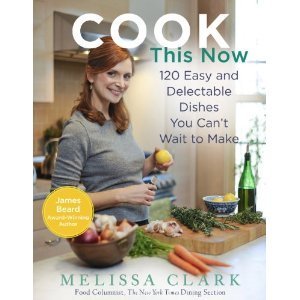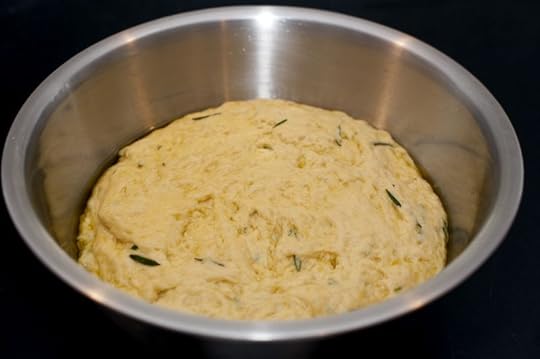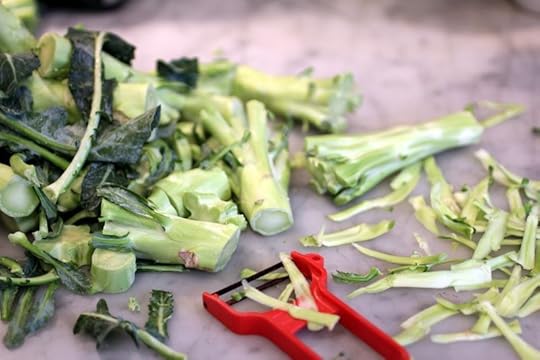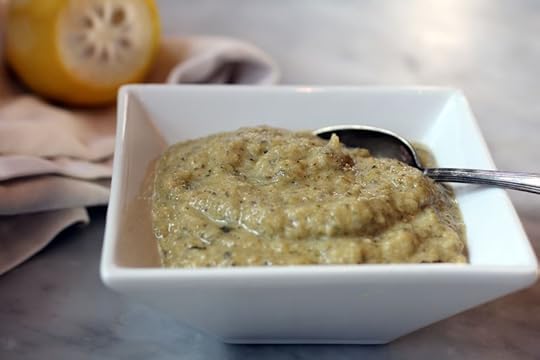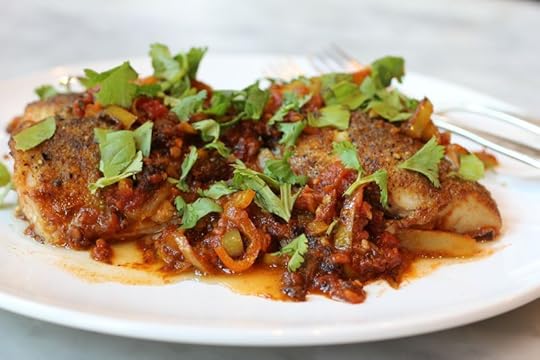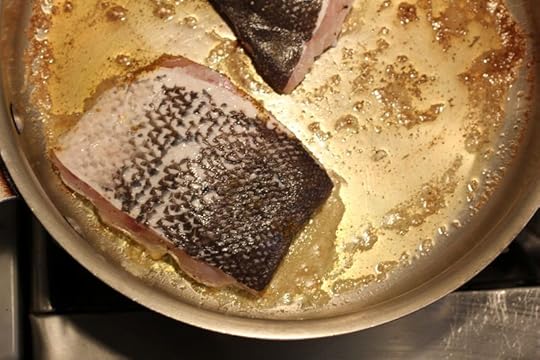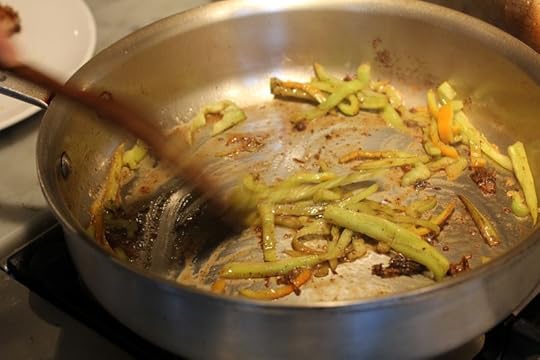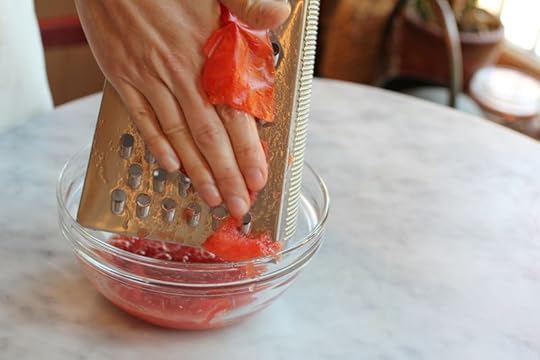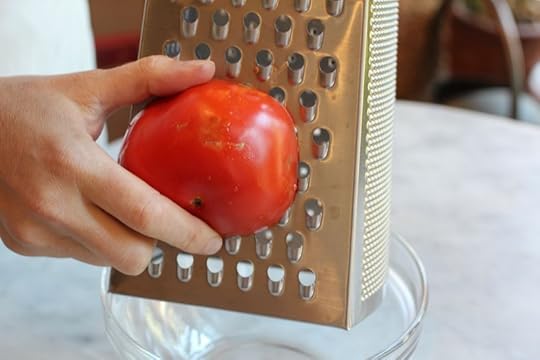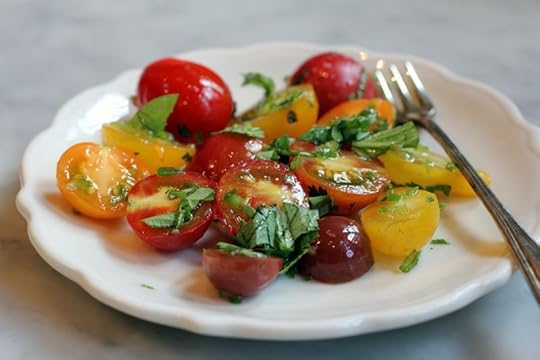Melissa Clark's Blog, page 5
October 7, 2011
Roasted Cauliflower with Fennel Pollen
[image error]
Roasted cauliflower is one of those simple, go-to dishes that I've been whipping up for years. Depending on her mood, Dahlia will even try some (though right now she prefers it steamed, which is unfathomable to me).
And as soon as it gets cool enough outside to crank up the oven, usually I cut up a cauliflower and throw it right in, letting it get golden, softened, and sweet under the intense heat (425 is about right, for about 30 minutes or so). Then I eat a big bowl of it for lunch or as a side dish with dinner, sometimes both on the same day if I've made a big enough batch. And I mean BIG batch; I can easily go through one small head all by myself for lunch. The stuff shrinks down, after all.
In my latest book Cook This Now, the sweetness of roasted cauliflower gets an earthy kick from coriander and cumin seeds, which I throw into the pan and let toast with the vegetable. This is pretty much my standard, I-don't-want-to-think-about-it recipe and I've made it so many times i can do it on autopilot. It always satisfies.
But yesterday, after yet another attempt at organizing my overflowing spice cabinet, the fennel pollen was front and center and readily available when I opened the cupboard. So for something a little different, after tossing the raw cauliflower florets with the requisite sea salt, fresh black pepper, and good olive oil, I added a good pinch of fennel pollen.
The flavor was lovely and subtle and sweeter than my usual spice mix. The cauliflower was still tender and satisfyingly crunchy where it had browned, and the fennel pollen lent a slight floral note that seemed to be an appropriate quality for an early autumn lunch. Which was just what I needed.
October 4, 2011
Cook This Now - OUT TODAY WHEE!
Hurray! It's finally here, my latest -- and possibly my greatest -- cookbook to date: "Cook This Now: 120 Easy and Delectable Dishes You Can't Wait to Make."
I couldn't be prouder or more excited about this new baby because it's the first book I've written that documents the actual food I make for my family on a daily basis. It's the recipes we all love, the ones my small child will happily eat, the ones my husband asks for over and over.
The book came about as a kitchen diary, literally. After years of my family and friends asking me to make that amazing whatever-it-was again, and me having totally forgotten what the heck I put in whatever-it-was, I finally started keeping a small notebook in the kitchen and jotting down recipes. That way when my sister Amy asked me to cook up that savory golden skillet chicken with fresh herbs I once made for a spring dinner, I could just go look it up instead of faking it with another dish. Ditto when my mother asked for the recipe for the figgy snacking cake with crunchy demarara sugar. I wouldn't have to admit, with shame, that I couldn't remember what I put in that batter other than a little whole wheat flour to give it chewiness and depth of flavor (yup, both those recipes are in my book).
What started to emerge was a pattern of seasonally-inspired recipes (I love me my farmers' market). So I organzied the book around the seasons. Each chapter corresponds to a month, and each month has 10 recipes using ingredients that are at their prime.
So for example January is about dark leafy winter greens and slowly stewed beans. August is about tomatoes, corn, and eggplants (The Best Tomato Sandwich, Roasted Ratatouille with Fresh Corn Polenta and Ricotta). October showcases warming, hearty recipes such as Three Meat Chili and Carroty Mac and Cheese. And in December, I use parsnips in my Hanukkah latkes because they taste so sweet and fruity it's as if the applesauce was fried right into the pancake instead of being spooned on top.
Unlike many, more cheffy seasonal cookbooks with esoteric or annoying ingredients (fava beans anyone?), mine are the simple, easy recipes that I can throw together at the end of a long day without fuss. They are the quick, satisfying dishes that reflect the foods that are the freshest and most flavorful because they are in season.
If you've ever been intimidated by the farmers' market, unsure what to buy and what to do with it once you got it home, this book will be your best friend in the kitchen. Or if you've wondered what to cook right now, this book will tell you what ingredients are at their best, and give some innovative and unusal ideas for using, say, skinny green beans, that you might not have ever seen before (how about with toasted walnuts in a simple, succulent salad).
And if that doesn't sell you, the photographs are mouthwateringly stunning, all taken by the amazing Andrew Scrivani.
I know you will love the book as much as I do (or I hope so at least!). Order your copy today or pick one up at your local book store! And let me know what you end up making for your family meal.
September 26, 2011
Kitchen Hip Tip: Moist Bread Dough = Tender, Fluffy Challah
Here is a challah trick that is applicable all across the sweet bread sphere: the moister, wetter and generally more difficult and sticky the bread dough, the more tender and cakey the bread will turn out. For challah and other egg and sugar-enriched doughs, this is exactly what you want.
My rule of thumb - only add enough flour for the dough to hold its shape. It should be a little sticky, but not unworkable. You should be able to knead it without it gluing itself to the counter (and your hands), but it shouldn't be bouncy and perfectly smooth, a little ragged around the edges is a good thing here. Add as little flour as you can bear and your challah will be all the softer for it.
Hope this helps and happy challah baking! And Happy New Year.
Oh and lest I forget, I have a recipe on Gilt Taste this week that is made for Rosh Hashanah - a honey glazed duck with apple and potato confit, so so good and I promise, it's really easy, not much hearder than roasting a chicken and so much more festive.
September 16, 2011
Leftover Broccoli Stem Soup
A few months ago, I tested a recipe for the Franny's Brooklyn Cookbook I'm working on. It was the simplest, more pure broccoli soup I'd ever eaten: rich and savory, but still tasting of the essence of the vegetable, made without any kind of stock. It was a chunky puree with a snowy mountain of good cheese on top, finished with a bright squirt of lemon.
The technique is pure genius on Andrew Feinberg's part (he's the chef at Franny's). Brown the broccoli thoroughly in plenty of oil, but only on one side. This builds a foundation of flavor without obliterating the peppery, green taste of the broccoli since one side is left unbrowned and naked.
I know this is a tease, because I can't publish the recipe until the book comes out, which won't be until--oh, around 2013. But I wanted to write about it because I made the soup again last week with some leftover broccoli stems and leaves (no florets) and it was just as wonderful. See how pretty:
photo by Olga Massov
I'd never been great at saving broccoli stems (confession time, I used to throw them out). I knew I wasn't supposed to. Everyone who was a better cook than I said to save them, peel them, and use them along with the florets.
But it just seemed like too much trouble. Anyway in this age of nose-to-tail vegetable cooking, I finally saved a pile of stems leftover from making my favorite garlicky broccoli salad for my friend Alice's book party. (Go buy her fantastic new book, Naked Wine - everything you want to know about natural and organic wines is in this book!)
I dutifully put them in a bag in the fridge, but, between you and me, I really didn't have much faith that I'd do anything other than throw them out once they started to get slimy in a few weeks. In the meantime they would torment me, making me feel guilty and inadequate.
Luckily, soup weather descended early and I remembered Andrew's fantastic broccoli soup. So I whipped up a batch with the stems. I didn't go too crazy with the peeling, just ran a peeler up the stalks to get rid of any brown spots. Then I chopped the stems up, along with the leaves, and browned everything in plenty of oil, in batches.
Cooking in batches is key here because if you overcrowd the pan, the broccoli will steam instead of brown. Once all the broccoli bits were crisp and golden, I salted them. Then took what was left after eating quite a few bites because you know, olive oil fried broccoli is crazy-good, added it to some sauteed onion and garlic, and poured in just enough water to barely cover everything. A few minutes of simmering brought the flavors together. Then I stuck in an imersion blender to smooth things out.
Some cheese on top (parmesan or pecorino), a squeeze of lemon, another drizzle of oil and it's a fantastic soup, perfect for today -- even if you end up making it with entire heads of broccoli and not just the stems.
September 6, 2011
End of Summer Blackfish with Tomatoes, Peppers, and Madras Curry Brown Butter
Excuse the awkward food styling here. Or more accurately, the complete lack of food styling. But I just couldn't wait to dig into this heady fish curry. The aromas were so savory, so rich and herbal and spicy that as soon as the two tender fillets were cooked through, I slid the mess from the pan onto a plate, asked Olga to snap a picture (hurry hurry!) and dug in. No time for food styling or fussing, not while my stomach was growling so audibly and persistently (though Olga did ask that next time I at least let her put the food on the plate in a more considered way and I agree that would have made for a prettier picture though not necessarily as good a lunch).
Anyway, this recipe is just the thing to make while you can still get good tomatoes and peppers from the market. The curry brown butter sauce just sort of happens as the butter browns while the fish cooks, and it mingles with the curry powder you've sprinkled on the fillets to season them. It sounds a lot fancier than it really is.
I love cooking with blackfish since it's local and thick and meaty and very sweet. But any fish would work well, even stronger ones such as mackerel and swordfish. What you want to do is brown the fish a little to flavor the sauce, then remove the fillets from the pan so they don't overcook while the sauce reduces. Then add the fish back in at the last minute to allow the flavors to come together. Just adjust the cooking time depending upon the type of thickness of your fillets (or steaks, those work too).
I used a Cubanelle pepper because I had one but any bell pepper is fine. Green ones add a grassy freshness; red or orange or yellow lend a sweeter taste. If you want some heat, throw in a sliced up jalapeno or serrano if you can take it.
Finally a word about the Madras curry powder: the best ones will have a spicy chili bite with some real tongue-zapping heat. If you only have regular curry powder, perk it up with a pinch of cayenne. And definitely make sure your spices are fresh and aromatic. Stale spices = flat boring curry. And who wants that?
End of Summer Blackfish with Tomatoes, Peppers, and Madras Curry Brown Butter
2 blackfish filets around 7 ounces each
Coarse sea or kosher salt
Pepper
Madras curry
2 tablespoons unsalted butter
2 tablespoons dry white wine
Olive oil
1 Cubanelle or bell pepper of any color, thinly sliced
1 clove garlic, minced
Zest of 1/2 lime
1 large tomato, grated
Cilantro, roughly chopped
Basil leaves, torn
Juice of 1/2 lime
1. Wash and pat dry the filets, making sure to pull out any pin bones. Season the fish with salt and pepper and generously sprinkle the curry powder. Allow the fish to "cure" for at least 30 minutes.
2. Melt the butter in a large skillet over high heat until the solids have settled at the bottom and bubbling has subsided. Add fish, skin side up, to pan and cook without moving it around until it is well browned, about 3 minutes; flip fish and continue to cook until it is just opaque. You will notice that the butter will have turned dark brown and nutty-smelling. You want this.
3. Transfer fish to a plate and set aside. If some of the fish skin sticks to the pan, ignore it, it will eventually meld into the sauce and add flavor. Add the wine to the pan and deglaze, scraping the brown bits and any skin that has stuck to the bottom.
4. Add the peppers to the skillet and sauté for 4 to 5 minutes, until slightly browned and softer. If the peppers look a little dry, add a splash of olive oil to them while sauteing. Stir in the garlic and lime zest, cook for 30 seconds until fragrant, and add the grated tomato. Cook until most of the tomato liquid has evaporated, about 2 minutes on high heat. Place the fish back into the skillet, cover, and cookuntil the fish is heated and cooked through. Serve fish sprinkles with cilantro and basil, and drizzles with lime juice.
Serves 2.
September 1, 2011
Kitchen Hip Tip: Grating Tomatoes Rids Peel & Purees Instantly
Have you ever grated a ripe tomato? No matter how many times I do it, I think it's thrilling. The best tomatoes for grating are so juicy and fat they treaten to burst in your hand even before they meet their grater.
Then all you do is halve your tomatoes and run the cut sides through the large holes of a box grater (over a bowl!) until the moist flesh is scraped away from the skin (discard skin or use it for another purpose though what that might be I can't imagine). Then use the pulp for sauces. No bits of tomato skin in the pan and grating is much easier than chopping wet, squishy ripe tomatoes, cubes of which inevitably fall off the cutting board and onto the floor with a splat.
August 29, 2011
A Cookbook Proposal Seminar Auction - #afundforjennie
By now, most folks in the food blogosphere and beyond have read about one of my friends, Jennie Perillo, and the sudden passing of her husband, Mikey. The online community came together by baking a peanut butter pie for Mikey, a request Jennie made on her blog.
Words cannot begin to describe what an ordeal Jennie is going through. Aside from emotional shock, the reality of dealing with financial burdens have set in. Once her husband's health plan runs out in December, the monthly payments will amount to more than her current mortgage payment. And then there is the not-so-small matter of raising two small daughters in New York City by herself, something she did not sign up for at the get-go.
There have been quite a few eloquent and moving posts written over the course of the last few weeks. Reading them makes me cry every time. There's a lot behind the tears, and I'll admit that as many of them have been squeezed out of my own experiences and fears as they are for Jennie's pain. I cry because I deeply care about Jennie. But in all honesty I also cry because I can so easily see myself in her place. And it scares the hell out of me. So I ask myself, what would I want my friends to do for me? That is what I want to do for Jennie, at least in the conrete ways that I can. I cannot make Mikey come back. All I can do is help cushion the hardship that she's facing, albeit it in a small way.
And in this spirit of help-where-we-can, a few folks got together to create A Fund For Jennie (Twitter: #afundforjennie). Maggy of Three Many Cooks and Erika of The Ivory Hut worked tirelessly to create a non-profit called Bloggers Without Borders, which organized the drive. The idea is to help at least offset the finacial woes as a community while we all help, in our own individual ways, the searing heartache Jennie is going through on a personal level.
Now, here is my auction. I'm offering a 3 hour long seminar for 4 people on writing a cookbook proposal via a blind email auction. Have you had a cookbook idea simmering in your head for awhile and weren't sure how to put the proposal together? Do you have a proposal that just needs a little something to give it the sizzle to sell for the big bucks (or any bucks?). I'm here to help you!
As the author of 32 books (yup, it's true), I have been through the ins and outs of the book publishing world. I can give you information about agents (getting one, making the best use of one, or do you even need one?), platforms (not shoes), publishing houses (the good, the bad, the ugly), editors (yay for editors!). And I can help you take your dream and walk you through the steps of creating a marketable book proposal. All you need is an idea and a passion and we will work as a group on the rest (during the 3 hour seminar.)
The seminar will meet in New York City, either at my place or one of yours, in January, February or March of 2012 on a mutually agreeable date. Five of us (four of you, and me) will get together and help each other in a CONFIDENTIAL, gentle and nuturing environment. Bring your idea, your half written proposal, excerpts from your blog, or nothing at all -- from whatever you have we can spin gold. And together we will write, critique and edit it into a viable draft of a proposal. I will give you the tools and blueprints you need to sell your book. You just need the drive and vision (or at least passion, I can help you sculpt the vision).
Here's what you do: send an email to fundforjenniemclark@gmail.com with your auction bid. The 4 highest bidders will win entrance to the seminar. If you want to bid with a friend, just send that info in the email and I'll try to make that work. Or if 4 of you want to bid together, that is great, too., I'll try to work with you. Be generous, this is for a good cause. A good person, a good family who need our help. Bidding starts at $300 per person. It will be well worth it. I'll bring snacks and wine. This will be fun, helpful, and very creative. At least, that's the plan.
Auction will close on Monday September 5th at noon. Then I will email the four highest bidders and coordinate dates, etc. Feel free to email questions.
Let the bids begin!
August 24, 2011
Southeast Asian Tomato Salad
Photos by Olga Massov
It's August, in fact we're halfway through August. And this means another sneak peek into my upcoming book, "Cook This Now" due out in October and is now available for pre-order!
***
I tossed this together one night to serve with the Thai-style ground turkey dish. It's a departure from my usual tomato salad, which is comprised of little more than carved up tomatoes, torn basil, salt, and olive oil. Daniel and I eat this simple salad almost every night in tomato season since it takes about 20 seconds to assemble and has a juicy purity of tomato flavor that I can't seem to get enough of this time of year.
But with the fish sauce, limes, scallions, and jalapenos for the turkey already sitting out within arms' reach, I decided to try something new.
It turned out to be insanely good, very tangy and a nice break from the more everyday, if tasty, tomato salads I usually make. I've since added it to our summer tomato rotation and find myself whipping it up even if I have to hunt in the cupboard for the fish sauce and sort through the vegetable bin for a jalapeno. It's worth the chase every time.
Makes 4 servings
About 2 teaspoons Asian fish sauce such as nam pla or nuoc mam, or to taste
2 teaspoons freshly squeezed lime juice
1 teaspoon light brown sugar
2 scallions, finely chopped
1 fat garlic clove, minced (or use 2 small ones)
1/2 jalapeno pepper, seeded, if desired, and finely chopped
3 large or 4 medium tomatoes, sliced 1/4-inch thick
2 tablespoons chopped fresh Thai or regular basil
2 tablespoons chopped fresh cilantro
1. In a small bowl, whisk together the fish sauce, lime juice, sugar, scallion, garlic, and jalapeno. (If you think your fish sauce is very salty, start with 1 teaspoon; you can add more at the end).
2. Arrange the tomato slices on a plate. Spoon the dressing over the tomatoes. Let stand 10 minutes to allow the tomatoes time to release their juices. Sprinkle with basil and cilantro; serve.
What Else?
- Cucumbers, that's what else. This salad is even better with some sliced cucumbers added to the mix. I didn't have any when I first made this, but if I had, I would have replaced one of the tomatoes with a nice big Kirby cucumber, sliced thin.
- If you have access to a tender lemongrass stalk, use it here in place of the scallion, or alongside it.
- Different brands of fish sauce (otherwise known as nam pla or nuoc mam) have different degrees of saltiness. It's less apparent when used in cooking, but when drizzled raw on salads you need to be careful. Start with a little and add more as you go. I used 2 teaspoons but trust your own palate.
- If you'd rather go for a bare-bones tomato salad, leave out all the ingredients except the tomatoes, salt, and basil. Add pepper to taste and toss well with a few drops of good olive oil. That's all you need.
A Dish By Another Name
For a Southeast Asian Tomato Noodle Salad double all the ingredients except for the tomatoes, which you should dice instead of slice. Toss with about 6 ounces of cooked rice noodles, then adjust the seasonings to taste. It will probably need a bit more fish sauce, lime juice, and sugar.
Melissa Clark's Blog
- Melissa Clark's profile
- 133 followers


